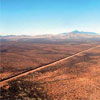
Bordering on Chaos
Do you believe you might have to defend yourself from terrorists in this country?
- By Ronnie Rittenberry
- Dec 01, 2012
From a security standpoint, things
don’t get much worse than the opening
scene of Lee Dodson’s Infiltration.
The book’s protagonist, a 67-year-old rancher
named Rand (picture a cross between Tommy
Lee Jones in “No Country for Old Men” and
Sly Stallone in “Rambo”), is awakened in his
home in the middle of the night by the subtle
but unmistakable sound of a silenced gunshot.
By the novel’s third paragraph, Rand’s
wife and son are dead. Before the end of the
first chapter, his ranch is razed and, from the
sound of reports in the distance, the same
nightmare has played out at the home of his
closest neighbors. Thoughts of security are
swiftly supplanted by those of survival, and
from there, the situation does not improve.
Rand, whose past is shrouded in the mists
of Vietnam, recognizes professionals when he
sees them and, even though he can’t fathom
the reason, soon realizes he’s up against a
coordinated and highly strategic attack by
a small army of well-trained killers. What
gradually unfolds is that the infiltrators—a
combined force of Mexican and Middle Eastern
terrorists—have special plans for the 20
square miles of Arizona desert that includes
Rand’s land, and those plans are aimed at
hurting America. What also comes to light is
that the terrorists have used the nearby porous
southern border to stage the assault and
that the plot’s leaders have been in the United
States for years, making the connections and
gaining the skills needed for the larger attack
to come.
It is a violent, bloody, and often tense
book, and, unfortunately, the particulars of
its plot are plausible. On that point, though,
not everyone agrees. According to Dodson,
some early readers of the novel have taken
issue with the very idea that, more than 11
years after 9/11, an attack of the same magnitude—
or worse—could happen again or
likewise from within.
“I’m getting that kind of feedback now—
you know, ‘What are you doing writing a book
like this because this is America—we’re safe,’”
the author said. “The gist of that feedback
is that this country is impregnable, but actually
that stopped being the case in the War
of 1812 when the British burned the White
House. And if you really want to talk about
being attacked, our consulate in Benghazi
was American soil, and that just happened.
The fact is, we are at risk. I think people sense
it, but it pisses them off to sense it.”
Domestic Intranquility
In an effort to ascertain what else his potential
audience might sense on the subject,
Dodson made the unusual move for a novelist
of posting a brief survey online; links to
the survey’s 10 questions were picked up on
50 different websites, mostly news sites. Beginning
the first week of October, he began
hearing from people all over the country. And
then the thing went viral.
“This is by no means a scientific survey,”
Dodson said. “Just a few questions to see
if terrorism awareness still has a pulse. . . .
People I know and speak with often are still
on edge, but are those just folks who were
around to hear World War II stories, or is
there a consciousness that because nobody
in power is talking about it, terrorism on our
soil is a thing of the past?”
Judging by responses to the survey, titled
“Today’s View on Homeland Terror,” awareness
is alive and well. After two weeks, Dodson
had collected more than half a million
responses and at least two crashed servers.
Of those who responded by mid-October,
94 percent said they do expect another major
terrorist attack on the United States, and 89
percent expected a weapon of mass destruction
to be involved in the attack. Asked, “Do
you think you might have to defend yourself
from terrorists in this country?” 90 percent
said yes. Interestingly, however, to the question,
“Do you know enough about what to
do if a terrorist attack strikes near where you
live or work?” only 15 percent answered in
the affirmative. Also interesting, 80 percent
said yes to “Do you think sleeper cells are
already in the United States?” and 77 percent
said no to “Do you believe the current
administration is truthful about terrorism in
this country?”
Comfortably Numb
“I wrote a scary book, but I wasn’t prepared
for what I’m seeing in the letters of people
who write me,” Dodson said. “There is an
undercurrent, an unspoken thing, and it’s not
fear or resignation—two big intended results
of terrorism. It’s an undercurrent of determination,
a feeling of ‘We will not be defeated,
no matter what they do to us.’ And that’s
largely the feeling of the book; it essentially
says that at some point you’re going to have
to fight.”
Dodson added that, meanwhile, he also is
aware of a prevailing undercurrent of unpreparedness—
a certain portion of the citizenry
composed of, as he put it, “unserious people
in a serious world.”
“I think some of us have failed to recognize
exactly how bad things can get,” he said.
“And I’m by no means pessimistic because
holding this country would be hard to do—
hard—but the bad guys can sure make us uncomfortable
in a lot of ways.”
This article originally appeared in the December 2012 issue of Security Today.